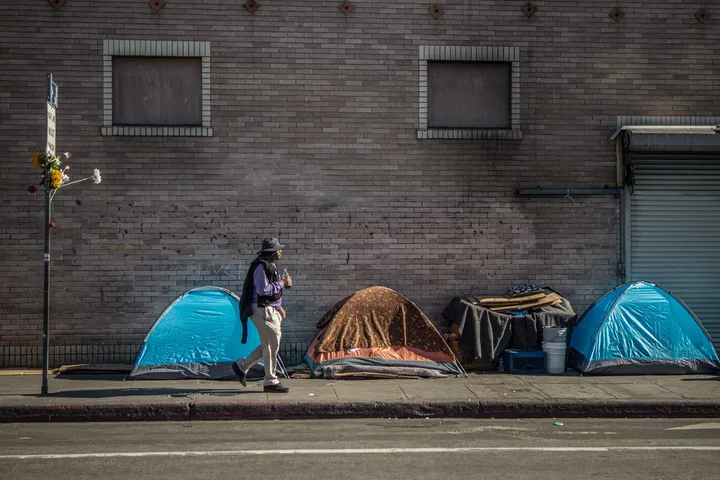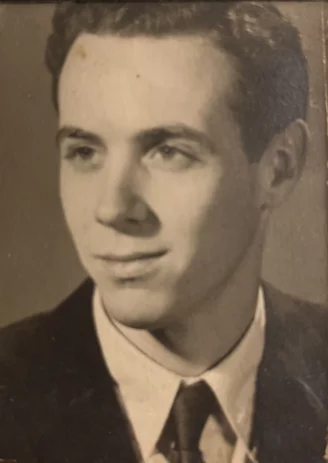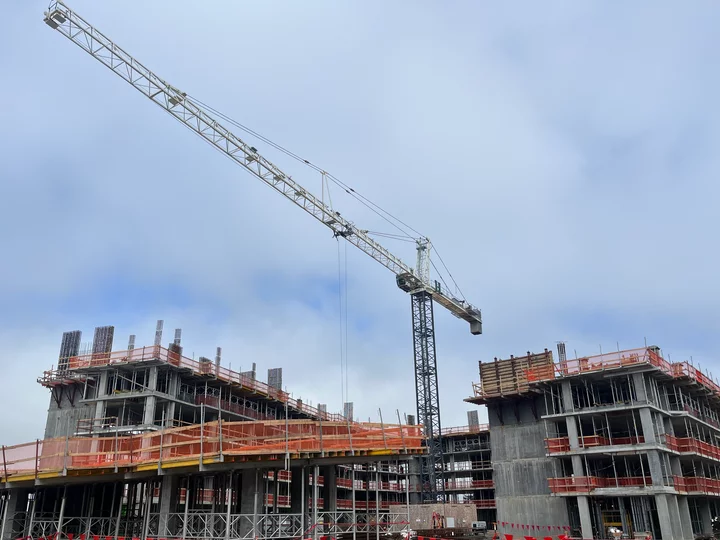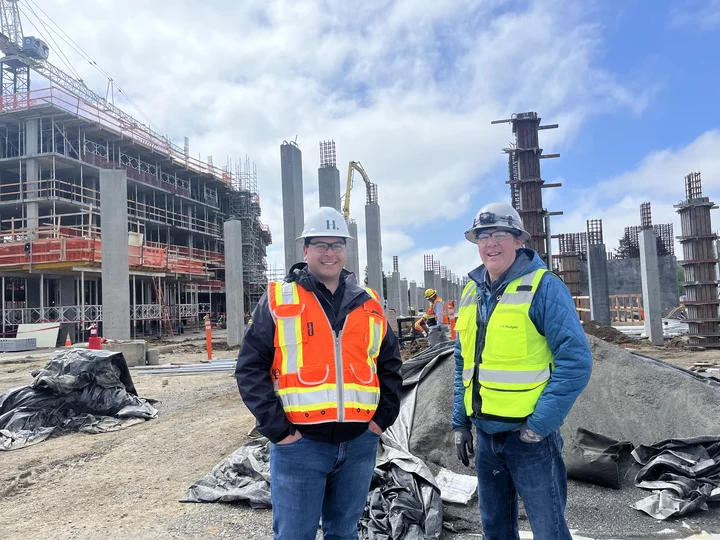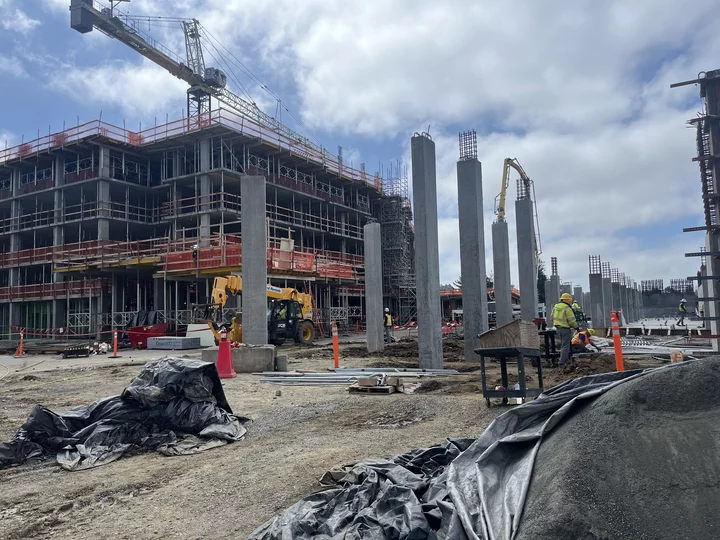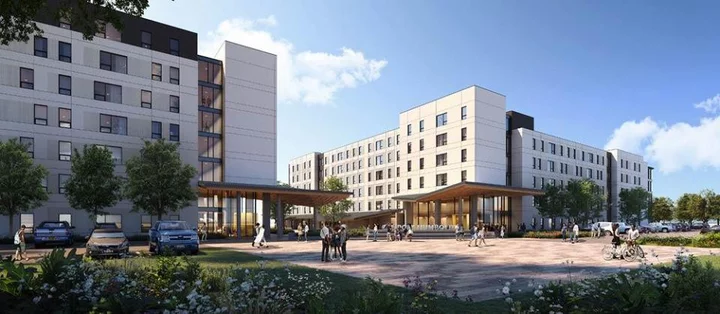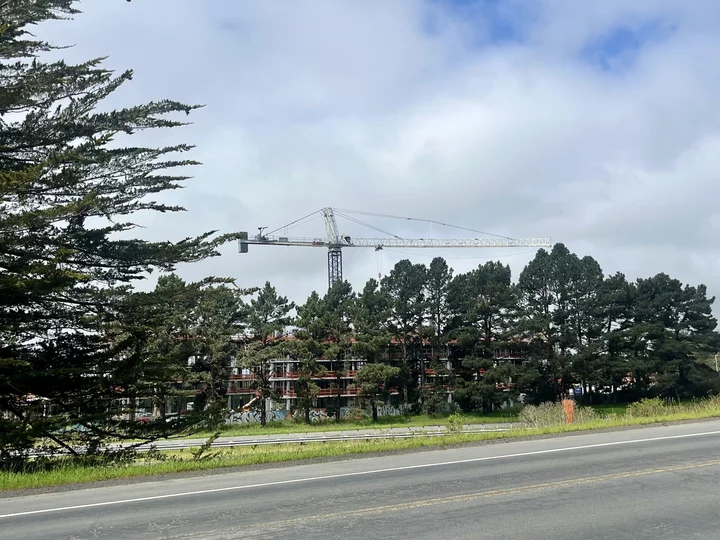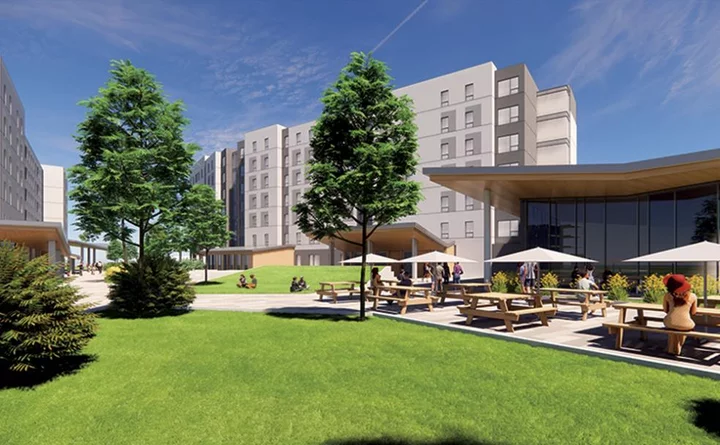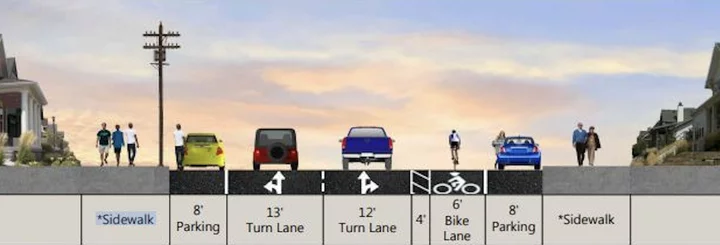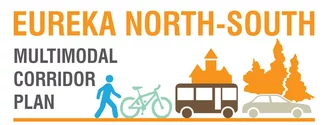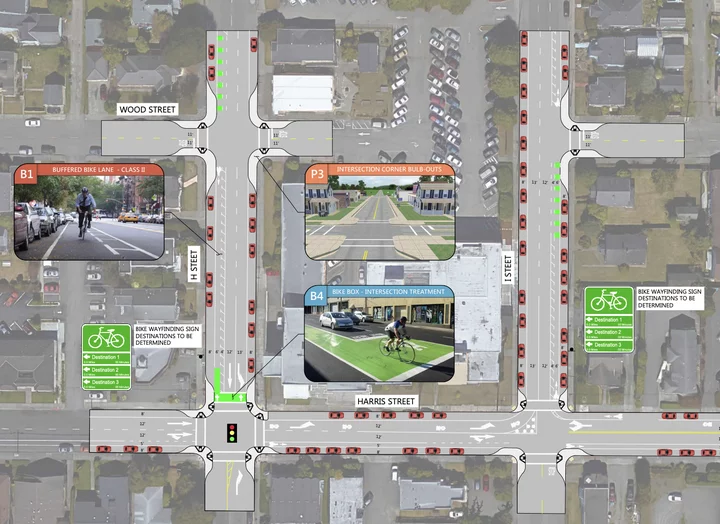California Fails to Track Its Homelessness Spending, Outcomes, Says New Audit
Marisa Kendall / Wednesday, April 10, 2024 @ 7 a.m. / Sacramento
A person walks by a homeless encampment in downtown Los Angeles on Nov. 18, 2022. Photo by Larry Valenzuela for CalMatters/CatchLight Local
Exactly how much is California spending to combat homelessness — and is it working?
It turns out, no one knows. That’s the result of a much-anticipated statewide audit released Tuesday, which calls into question the state’s ability to track and analyze its spending on homelessness services.
The state doesn’t have current information on the ongoing costs and results of its homelessness programs because the agency tasked with gathering that data — the California Interagency Council on Homelessness — has analyzed no spending past 2021, according to the report by State Auditor Grant Parks. Three of the five state programs the audit analyzed — including the state’s main homelessness funding source — didn’t even produce enough data for Parks to determine whether they were effective or not.
The audit also analyzed homelessness services in San Jose and San Diego, finding both cities failed to thoroughly account for their spending or measure the success of many of their programs.
“The lack of transparency in our current approach to homelessness is pretty frightening,” said Assemblymember Josh Hoover, a Republican from Folsom who co-authored the request for the audit.
That means state policymakers have little data to go on when they make funding decisions related to what has become one of California’s most dire challenges.
“The State Auditor’s findings highlight the significant progress made in recent years to address homelessness at the state level, including the completion of a statewide assessment of homelessness programs,” the Interagency Council on Homelessness wrote in an emailed statement. “But it also underscores a need to continue to hold local governments accountable, who are primarily responsible for implementing these programs and collecting data on outcomes that the state can use to evaluate program effectiveness.”
Tens of billions of dollars, nine agencies and more than 30 programs
As the homelessness crisis has intensified, California under Gov. Gavin Newsom’s leadership allocated an unprecedented $24 billion to address homelessness and housing during the last five fiscal years, according to the Legislative Analyst’s Office.
Nine state agencies administered more than 30 programs aimed at preventing or reducing homelessness. Some of those programs did such a poor job tracking their outcomes that it’s impossible to tell if they’ve been successful, according to the audit, which marks the first such large-scale accounting of the state’s homelessness spending.
The report evaluated five state homelessness programs and found two “likely” are cost-effective. Newsom’s signature Homekey program helps cities and counties turn hotels and other buildings into homeless housing at an average cost of $144,000 per unit (in the program’s first round), compared to the $380,000-$570,000 it would cost for new construction. The CalWORKS Housing Support Program, which gives financial help to families who are homeless or at risk of becoming homeless, also saves the state money because it’s much cheaper to help someone stay housed than it is to help them find housing once they become homeless.
The auditor found the CalWORKS program spent an average of $12,000-$22,000 per household, while a single chronically homeless person can cost taxpayers as much as $50,000 per year.
But for three other programs, the state hasn’t collected enough data for the auditor to make an assessment: the State Rental Assistance Program (which helped people pay rent and other expenses during the COVID-19 pandemic), the Encampment Resolution Fund (a program Newsom launched to help cities clean up specific encampments) and the Homeless Housing, Assistance and Prevention program (the state’s main source of general homeless funding, also known as HHAP).
“Fundamentally, the audit depicts a bit of a data desert,” Sen. Dave Cortese, a Democrat from Santa Clara County who joined Hoover in asking for the audit, said during a media call.
For example, nearly one-third of people who left placements funded by the Homeless Housing, Assistance and Prevention program left for “unknown” destinations, according to the auditor’s analysis of round-one funding in Los Angeles, San Diego, Santa Clara and San Francisco counties. That ambiguous data makes it impossible to tell if the program has been successful, the auditor wrote. Even so, the state authorized billions of dollars for four additional rounds of funding.
“The lack of transparency in our current approach to homelessness is pretty frightening.”
— Assemblymember Josh Hoover, Republican, Folsom
The auditor laid some of the blame on the Interagency Council on Homelessness. Legislators instructed the council in 2021 to collect funding data on all state homelessness programs. The council did so once, reviewing data from 2018 through 2021, but has taken no action since, according to the report.
In a written response to the audit, the council said it doesn’t have the funds to continue collecting that data.
There also were a number of errors in the statewide system that collects data on homeless individuals and shelter capacity in each county. More than 100 records had clients with names such as Mickey Mouse, Super Woman or even Test Participant. One shelter reported nearly 1,100 people enrolled in a facility with fewer than 300 beds.
Should California pause its spending on homelessness?
Hoover hopes he and his colleagues in the Legislature will draft several bills this year aimed at improving transparency in state homelessness spending.
“We should freeze any new investments and additional investments until we can figure that out,” he said.
Cortese disagrees.
“I don’t think it’s a time to stop,” he said during the media briefing. “I would be disappointed personally, professionally as a state senator, if the governor or Legislature negotiated away this year’s investment in homelessness.”
In the midst of a major deficit, Newsom’s proposed budget for the upcoming fiscal year didn’t cut funding already allocated to the homelessness crisis, but it didn’t propose any new funds, either. For three years in a row, Newsom had granted $1 billion for local homelessness programs — but now the future of that funding remains up in the air. A group of supporters gathered at the state capitol earlier this month to urge the governor and legislators to authorize ongoing funding. Activists have been pushing for years for a permanent source of funding to fight homelessness, but so far Newsom’s administration has resisted, instead parceling out one-time grants each year.
The estimated number of unhoused Californians has increased from about 151,000 in 2019 to more than 181,000 last year. More than two-thirds of those people are living on the street or in places unfit for human habitation — not in shelters.
Cortese began pushing for the audit after visiting a massive homeless encampment on vacant land near San Jose’s airport, where hundreds of people lived among rodents, massive piles of trash and broken-down cars and RVs. When he started asking whether state funding was going to that encampment, he couldn’t get a clear answer.
And despite the Newsom administration pouring billions into the homelessness crisis and launching several new programs aimed at moving people indoors, encampments still are rampant up and down California. The perceived lack of progress led lawmakers to ask: Where is all that money going?
The state’s legislative audit committee unanimously approved the audit request in March 2023, and it initially was expected to be finished by October.
San Jose and San Diego fail to track homelessness spending
San Jose and San Diego each have spent hundreds of millions of dollars on homelessness in recent years. But neither could provide an exact accounting of how much was spent and where it went, according to the audit.
And both cities failed to consistently evaluate whether the homeless services nonprofits they contract with are effectively spending city funds. In San Diego, for example, a $1.6 million shelter contract didn’t specify how many people should be served, making it impossible to tell if that program has been successful. Even when the cities required performance metrics from their contractors, they sometimes failed to collect them.
Other times, the cities failed to act upon the data collected. A shelter provider San Diego contracted with had a goal of getting 26% of the people who left the shelter into permanent housing. Instead, about 6% went into permanent housing. Even though the provider fell far short of its goal, the auditor found no evidence the city took steps to analyze the contract’s effectiveness.
“Fundamentally, the audit depicts a bit of a data desert.”
— State Sen. Dave Cortese, Democrat, Santa Clara
In San Jose, the city extended an $8 million homelessness prevention contract based on vastly inflated performance data, according to the audit.
“I completely agree with the notion in the audit that we need to set goals, measure performance and improve transparency and accountability,” San Jose Mayor Matt Mahan said in an interview. He recently helped launch a public dashboard that tracks his city’s homelessness spending and outcomes.
But the state needs to help, he said. The city gets funding from several different state programs, and it’s often not clear across each program what types of performance metrics they should be using, Mahan said.
San Jose and San Diego have similar estimated homeless populations — 6,340 and 6,500 respectively. But San Diego has 4,000 emergency shelter and temporary housing beds, while San Jose has just 2,500, according to the report.
And both cities lack enough permanent housing for their homeless residents — as well as any comprehensive plan to fund and build the housing they need. San Jose hasn’t even calculated how many new homes it needs, according to the audit.
In San Jose and San Diego, more than 85% of the placements made for homeless residents are into temporary — not permanent — housing. As a result, around 40% of the people who leave those placements return to the street.
Both cities are taking steps to reduce the health and safety risks associated with homeless encampments by providing trash pickup, toilets, showers, medicine and other services. In San Jose, the budget for those services increased from $12.7 million in the 2020-21 fiscal year to $19 million last year. In San Diego, it grew from $32 million to $43 million. But neither city is doing a good job of evaluating the outcomes of those efforts, according to the audit.
San Diego Mayor Todd Gloria defended his city’s approach to homelessness in an emailed statement. The city served more than 11,400 people last year, he said.
“All of us can use this audit as a tool to understand how much more needs to be done in order to continue meaningfully addressing homelessness,” he said, “and we hope to impress on state leaders the need for adequate and ongoing funding for California’s biggest crisis.”
The auditor recommended San Jose and San Diego should, by September, report all of their homelessness-related spending in one central location and improve the way they evaluate the effectiveness of their homelessness programs.
In a written response to the audit, San Jose said it already is taking steps to better document its homeless services budget and more thoroughly assess the effectiveness of its programs. San Diego said it recently hired new staff dedicated to performance monitoring.
Todd Langton does outreach in homeless encampments throughout Silicon Valley in his role as founder of the Coalition for the Unhoused of Silicon Valley and executive director of homeless services nonprofit Agape Silicon Valley. Based on what he’s seen on the ground, he’s “not surprised at all” by the results of the audit.
Langton said he often finds small nonprofits, such as his own, are more successful at getting people housed than the larger nonprofits that eat up state and city funding.
“As advocates,” he said, “we just shake our heads and say, ‘They’re spending so much money on this. What’s going on?’”
###
CalMatters.org is a nonprofit, nonpartisan media venture explaining California policies and politics.
BOOKED
Yesterday: 3 felonies, 11 misdemeanors, 0 infractions
JUDGED
Humboldt County Superior Court Calendar: Today
CHP REPORTS
Hayfork (RD office): Assist CT with Maintenance
Mm101 N Hum 118.00 (HM office): Trfc Collision-1141 Enrt
ELSEWHERE
RHBB: 29-Year-Old Drowns on Lake Shasta
RHBB: Mendocino County’s newest neighborhood Fire Safe Council gets right to work
RHBB: Road Construction in Eureka Starting Today Through August 1 on a Number of Streets
Governor’s Office: Governor Newsom signs legislation 7.28.25
OBITUARY: Ryan Phillip Abbot, 1982-2024
LoCO Staff / Wednesday, April 10, 2024 @ 6:56 a.m. / Obits
Ryan Phillip Abbot
October
21, 1982 - February 28, 2024
Ryan Phillip Abbott was born in San Diego. He enjoyed a happy and active Southern California childhood, bodyboarding in the Ocean Beach surf with his brother, and playing baseball and soccer. He graduated from Point Loma High School.
He relocated to Northern California, living and working in Eureka until he joined the United States Air Force in 2006 and trained as a Civil Engineer.
Ryan’s first station was Malstrom Air Force Base in Montana. He was later deployed to both Iraq and Afghanistan. His last base was Ramstein Air Force Base in Germany, from where his team was also assigned duty at Aviano Air Force Base in Italy.
His military honors include, among several others, the Air Force Achievement Medal, medals with stars for both the Iraq and Afghanistan Campaigns, medals for National Defense Service, Global War on Terrorism Service, and a NATO medal. Among his awards are also ribbons for Air Force Longevity Service, Air Force Expeditionary Service, and Overseas Service. Ryan was honorably discharged as a Senior Airman after serving seven years.
Ryan continued his education while working first in San Diego and later in Eureka before making Elko, Nevada his home for several years. He returned to Eureka in 2023.
After months of failing health, Ryan passed away at home in Eureka, in his mother’s loving care.
He is survived by his mother Pamela Longacre, his father Jeffrey Abbott (Heidi), brothers Clark (Amanda), and Kent. He was predeceased by his stepfather, Donald Longacre.
Ryan’s ashes will be interred at Miramar National Cemetery in San Diego on April 16, 2024 at 12:30 p.m.
Donations may be made in Ryan’s memory to Canine Companions Northwest Training Center in Santa Rosa.
###
The obituary above was submitted on behalf of Ryan Abbott’s loved ones. The Lost Coast Outpost runs obituaries of Humboldt County residents at no charge. See guidelines here.
OBITUARY: James Darrell Bilderback, 1930-2024
LoCO Staff / Wednesday, April 10, 2024 @ 6:56 a.m. / Obits
James
Darrell Bilderback passed peacefully from this world the afternoon of
March 20, 2024. He was born in Eureka, the son of Dora Mozettti
Bilderback and William James Bilderback. He lived 93 (almost 94)
years filled with love, purpose, travel, and service to his community
as a teacher.
He was known as Jim, Dad, Grandpa, Uncle Sam, Uncle Donny and Mr. Bilderback. He was a favorite uncle who, in his younger years, took his nephews on trips to discover different places throughout the country. He loved to travel internationally. He met his wife Marilyn when a local couple invited them both to view travel slides, hoping they would hit it off. Apparently he squirted her in the face with whipped cream while serving her dessert that evening, a memory which was often repeated. They were married in 1968, and rumor has it they traveled to over 100 countries (on every continent.) His favorite was Bhutan, whose people he described as incredibly peaceful and content, but he had good things to say about each place and people everywhere, including Kenya, where he met a hippopotamus face to face.
He spent most of his life in Eureka, with the exception of a year in San Francisco working in a Christian book store and his time in the air force. He was stationed at Travis Air Force Base in California, and then in Okinawa during the Korean War. He was impressed by the resourcefulness of people he met there, and he always maintained a perspective of gratitude for his blessings. He served the end of his enlistment at the Pentagon, and was grateful for the educational and home ownership benefits provided by his country in exchange for his service.
An alumnus of Humboldt State University, he was a true bibliophile with a library of books on world cultures, natural wonders and the pursuit of truth. He genuinely loved talking about the weather and held a soft spot in his heart for all creatures great and small, especially dogs. He would get seemingly perturbed at the family dog for messing up the house and garden, but end up spoiling him with a towel on the couch and football throws. He got a tremendous kick out of training him to sit for his dinner and treats, and always made sure that the home was well stocked for his visits. He took pride and joy in making sure that everyone and everything was attended to.
He taught social studies at three junior high schools in Eureka: Jacobs, Zane and Winship. He was known for sharing his travel slides with his students, and being a strict but good teacher that really wanted his students to learn and become caring and engaged citizens of the world. He was a devoted husband to the love of his life, and a loving father and grandfather, celebrated for his pillow fighting and waffle making skills. He kept his yard looking spectacular and was dedicated to using gardening methods that caused minimal harm to all its inhabitants. He maintained beautiful rose bushes and a wide variety of ornamentals, working outdoors regularly until a year before his passing.
He was preceded in death by his mother and father, his sister Helen Lampella, and brothers Vernon and Eugene (Mick) Bilderback. He is survived by his wife Marilyn, daughter Marcia, grandson Kaiteo, niece Jo, nephews Jim, Gene, David, Michael, Rick, and Gary, as well as many of their children and grandchildren. He will be deeply missed, but will live on in the lives of those he touched and in the wonders of the world which he held in such reverence.
An intimate celebration of his life was held with family following his passing. Donations are welcome and can be made in his name to the Humboldt Library Foundation or the American Cancer Society.
###
The obituary above was submitted on behalf of James Bilderback’s loved ones. The Lost Coast Outpost runs obituaries of Humboldt County residents at no charge. See guidelines here.
ONE YEAR IN: The Outpost Tours the Site of the Giant Student Housing Project That Could House Nearly 1,000 Cal Poly Humboldt Students, Despite Slow Growth in Enrollment Numbers
Stephanie McGeary / Tuesday, April 9, 2024 @ 1:08 p.m. / Cal Poly Humboldt , Housing
One of the housing buildings under construction on the east side of the Craftman’s Mall site, and the familiar giant crane overhead. | Photos: Stephanie McGeary
###
It’s been nearly a year since Cal Poly Humboldt broke ground on the new student housing project at Arcata’s old Craftsman Mall sitee. Many of you have likely seen the giant tower crane or the top of the in-progress building poking above nearby trees.
The Outpost wanted to take a closer look, so last week we joined Mike Fisher, associate vice president of facilities management at CPH, and Fred Saldana, construction manager for FS3, for a tour to learn more about the largest development Arcata has seen in a long time. Once finished, the project will house up to 964 students at a time.
With construction still underway, it’s difficult to imagine the completed project, but Fisher and Saldana did their best to paint a picture as we toured the site.
The development includes two large buildings at staggered heights. The larger one, on the east side, will reach seven stories while the smaller will reach six. The taller building should be completed by the end of summer 2025, followed a few months later by the smaller one. Together they’ll hold 241 housing units, including two-, three- and four-bedroom apartments, each with its own kitchen and common room.
Fisher (left) and Saldana in front of the construction site.
In addition to housing, the project will include a gym, lounge areas, conference rooms and private study rooms. Between the two buildings will be an open walkway, which Saldana said will have the feel of a European “mews” – small, alley-like streets that aren’t open to vehicular traffic.
The site will have 320 parking spaces in multiple lots — not enough for every student to have their own space, but Fisher said alternative forms of transportation will be encouraged, and a shuttle service will run between the housing site and campus.
As part of the project, the university agreed to provide funding for the City of Arcata to complete a segment of the Annie and Mary Trail along the east side of the complex, and provide a shortcut for biking or walking to campus. Fisher said Arcata is trying to open the trail around the same time as the housing development.
The project will include covered bike storage in a one-story building just south of the main buildings. This building will also have a café, which will be open to the public, as will the project’s outdoor areas, though dorm rooms and certain other facilities will be accessible only to students.
Since many construction projects have been delayed due to the wet winter and supply chain issues compounded by COVID, we were pretty surprised when Saldana said the housing project is on schedule. He said the team planned for contingencies and while certain tasks, like pouring concrete, can’t be done in the rain, other work can be done in inclement weather, and planners obtained materials far in advance.
Still, the project had its unique challenges. Saldana and Shawn Marty, the project manager for Sundt Construction who joined the tour for a bit, explained that the long-unused property needed a lot of work before construction could begin. Temporary asphalt roads were added for trucks and machines access.
Above: what it looks like now. Below: what it is going to look like (rendering from CPH website)
“The key was getting the roads in so we wouldn’t be destroying the grounds,” Marty said. “And we got in the big stuff before the rains started.”
While laying down those roads, the team was surprised to unearth about 300 feet of buried railroad. Apparently, back when the site housed a sawmill, an industrial railroad spur was built to help load and unload materials from railcars.
The other big pre-construction step was getting the giant tower crane in place. Saldana said the crane was delivered in sections on 18 different trucks and assembled onsite.
With the development happening in quiet li’l Arcata, noise has been a public concern. However, the giant crane is not the culprit; it’s actually incredibly quiet when in use. But trucks’ backup beepers and other construction noise have led to complaints, Fisher said.
Project managers set a noise threshold with the City, Fisher said, and someone conducts “noise sampling” every two weeks to ensure the noise output is below that threshold. Of course, this doesn’t completely stop the complaints.
“It gives us a reference point, but people’s perception and experience is not just about numbers,” Fisher said. “If someone complains, we try to position [machines] in a different way or ask workers to limit use of their backup beepers or something like that. We try to be as flexible as we possibly can while still delivering the building on time.”
A pair of electricians map out their plans.
What about noise from partying students? Fisher said that, like the dorms on campus, each floor will have two to three resident advisors (RAs) in charge of monitoring and reporting issues to management, and the property will be patrolled by the University Police Department.
And for any neighbors worried about parties and general dorm-room debauchery, it might ease your concerns to know that the new buildings will be reserved for upperclassmen, while freshmen and sophomores will mostly be housed on campus.
With the project on schedule, Fisher said the housing should be ready for occupancy by fall 2025. The university will start marketing it this summer and assigning students to it next summer.
But with Cal Poly Humboldt’s enrollment numbers not nearly as high as expected after the transformation to a polytechnic, is this nearly 1,000-bed facility necessary?
Fisher believes it is, and he stressed that, although the growth has not been as rapid as the university anticipated, enrollment will continue to grow, even with total college enrollment decreasing over the past decade.
“Last year was about a 2.5 percent enrollment increase from the previous year,” Fisher said. “But we had lofty expectations, so the difference between those expectations versus what we’re experiencing is significant. But the story is we’re still growing amidst a higher education non-growth or even contraction.”
Fisher added that the new facility should help increase enrollment because once potential students see this impressive new development, they’ll really want to live there and will simply be unable to resist attending Cal Poly Humboldt.
“The better amenities we put out there, the more attractive we’ll be,” Fisher said. “And higher education is not just about the quality of the educational program; it’s also the quality of where you live.”
View of the construction from LK Wood Boulevard.
Another rendering of the plans, looking from the south.
(VIDEO) Watch a Great Blue Heron Snatch a Rodent Meal Out of an Arcata Lawn
Ryan Burns / Tuesday, April 9, 2024 @ 11:07 a.m. / Hardly News , Wildlife
Video submitted by Cora Lee.
###
Arcata resident Cora Lee sends along this video she recently captured of a great blue heron stalking and killing an unsuspecting little rodent (a mole?) from a lawn in Arcata.
We may tend to think of these elegant birds more as fish eaters, but they’re not picky. A great blue heron will eat pretty much any species big enough for a meal, including amphibians, reptiles, invertebrates, small mammals and even other birds.
The Cornell Lab’s All About Birds website describes their methods of stealthy hunting:
Hunting Great Blue Herons wade slowly or stand statue-like, stalking fish and other prey in shallow water or open fields. Watch for the lightning-fast thrust of the neck and head as they stab with their strong bills.
Ah, the circle of life.
This Month Eureka WiIl Begin Repainting H and I Streets to Implement New Lane Configurations
Andrew Goff / Tuesday, April 9, 2024 @ 10:52 a.m. / Traffic
City of Eureka release:
Beginning this month, contractors will be striping the new lane configuration on “H” and “I” Streets from Harris to 6th Streets. The new setup will include two through lanes for motorized vehicles, with a buffered bike lane for safer and more comfortable non-motorized use of the roadway.
The City of Eureka has received a Caltrans Sustainable Communities Grant (SCG) for multimodal transportation design, planning, and technical assistance for the completion of a multimodal plan. The project area is located between J and E Streets from 6th Street to Harris Street with a focus on H and I Streets. The multimodal plan will look at these north-south transportation corridors within the City for enhancing safety and mobility for all modes of transportation.
The City of Eureka Development Services and Public Works Departments are collaborating with Redwood Community Action Agency to engage residents, youth, and local businesses in re-envisioning H and I Streets and potentially adjacent north-south routes to improve safety for all users and foster vibrant neighborhoods and business districts.
Resident, youth, and local business participation will be integral to the success of this project. The City and Redwood Community Action Agency (RCAA) will conduct public outreach efforts to engage the community, and receive input to understand the diverse needs of the community, and also to solicit input on the development of the alternatives. Click here to provide feedback in our online survey.
Included in the objectives and goals for the project is the identification of at least three conceptual design alternatives for improved mobility, safety, and user experience for all modes within the project area with the focus on H and I Streets in the City of Eureka. In addition will be the completion of a Multimodal Plan for the project area with the focus on H and I Streets and the north-south transportation corridors within the city for enhanced safety and mobility for walking, biking, accessing transit, and motor vehicles.
One of many images included in the City of Eureka’s North-South Multimodal Corridor Plan. Find the whole plan here.
Eureka Mayor to Host Day-Long Town Hall Event With ‘Skidrow CEO’ as Part of Mental Health Awareness Month
LoCO Staff / Tuesday, April 9, 2024 @ 10:23 a.m. / Community
City of Eureka release:
The City of Eureka Mayor’s Initiative in partnership with the National Alliance on Mental Illness and the Department of Health & Human Services invite the community to “Embracing Humanity” a town hall event to kick-off and celebrate Mental Health Awareness Month on Saturday, May 4, 2024 from 10AM-4PM at City Hall in Eureka.
The morning will include two panels comprised of local professionals and individuals with lived experience in the mental health realm. The afternoon will include an inspiring keynote speech by Joe Roberts aka the “Skidrow CEO” who will share his personal story of perseverance: Roberts overcame homelessness and eventually succeeded in business before devoting his life to advocacy.
This event is a continuation of the City of Eureka Town Hall events held throughout 2023 focused on mental health, homelessness, and substance use related issues in our community. The aim of the day is to encourage community members to reflect on mental health, highlight key leaders in the community, discuss local resources and needs, and to brainstorm connections and solutions going forward. Community based problems require community based solutions. We look forward to you joining us!

